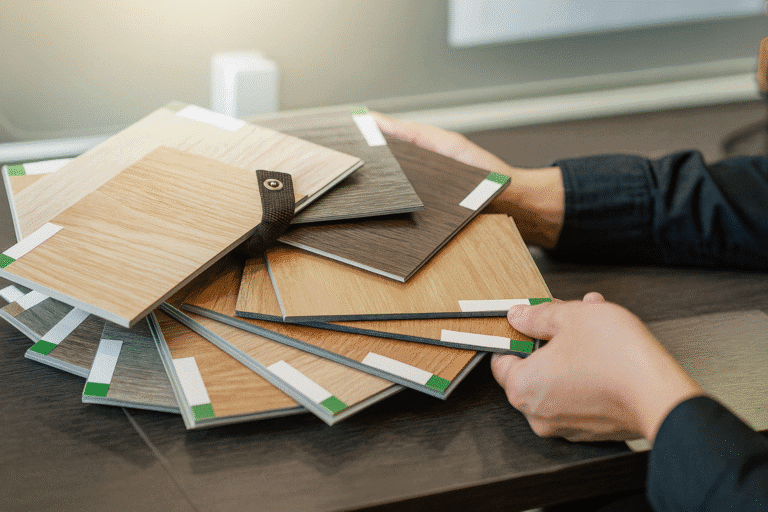Discover the key differences between hardwood flooring vs. laminate flooring to choose the right option for your space.
Choosing the right flooring for your home is a significant decision, and understanding the differences between hardwood flooring vs. laminate flooring is essential. Both options have their unique advantages, aesthetic appeal, and maintenance requirements, making it crucial to evaluate them according to your needs, budget, and lifestyle.
In this detailed guide, we’ll explore the distinctions between hardwood and laminate flooring, comparing aspects like durability, cost, appearance, and installation to help you make an informed decision.
What is Hardwood Flooring?
Hardwood flooring is made from solid pieces of natural wood, typically harvested from trees like oak, maple, cherry, or walnut. This flooring type offers unmatched elegance and authenticity, giving your space a timeless and high-end look. Hardwood planks are milled from real timber and can be purchased as solid or engineered wood.
Solid hardwood planks are made entirely of wood and can be sanded and refinished multiple times over their lifespan, which can extend for decades or even generations. Engineered hardwood, on the other hand, consists of a real wood veneer layered over plywood or high-density fiberboard (HDF). It offers enhanced stability and resistance to humidity compared to solid wood.
What is Laminate Flooring?
Laminate flooring is a multi-layer synthetic product designed to mimic the look of real wood. It’s composed of four layers: a wear layer, a design layer, a core layer, and a backing layer. The top layer is a protective coating that guards against scratches and stains, while the design layer features a high-resolution image of wood, stone, or tile, providing the aesthetic appeal.
Laminate’s core is usually made from high-density fiberboard, giving it structural stability. The product is popular for its affordability and ease of installation, making it a favorite among DIY enthusiasts. Laminate flooring often uses a click-and-lock system, allowing for quick installation without the need for glue or nails.
Durability and Longevity: Hardwood vs. Laminate
When comparing durability and longevity, both hardwood flooring vs. laminate flooring have their strengths.
Hardwood Flooring: Real hardwood is known for its durability, especially when properly maintained. Solid wood can be sanded and refinished multiple times, extending its lifespan to 50 years or more. However, it is susceptible to scratches, dents, and moisture damage, which can cause warping or discoloration.
Laminate Flooring: Laminate is designed with durability in mind, particularly when it comes to resisting wear and tear. The tough top layer protects against scratches, stains, and fading, making it an ideal choice for high-traffic areas or homes with pets and children. However, once laminate is damaged, it cannot be refinished like hardwood. The lifespan of laminate flooring is typically 15 to 25 years.
Cost Comparison: Hardwood Flooring vs. Laminate Flooring
Hardwood Flooring: Real wood flooring is a premium product, with costs varying depending on the wood species, grade, and finish. The initial investment is higher, ranging from $8 to $15 per square foot for materials alone. Installation adds to the expense, with professional fitting required due to the complexity of the process.
Laminate Flooring: Laminate is a budget-friendly alternative that provides the look of wood without the high cost. Prices typically range from $1 to $5 per square foot, making it a more accessible option for many homeowners. Installation is also less expensive since many types are designed for easy DIY installation, reducing labor costs.
Appearance and Aesthetic Appeal
Hardwood Flooring: The beauty of genuine wood is unmatched. Each plank offers unique grain patterns, textures, and color variations that add warmth and character to a space. Over time, hardwood develops a natural patina that enhances its aesthetic appeal. The ability to sand and refinish solid wood allows homeowners to update the look of their floors as trends change.
Laminate Flooring: Advances in technology have allowed laminate flooring to closely mimic the appearance of natural wood. While it may lack the authenticity of real wood, the design layer can capture realistic wood textures and patterns. However, it’s important to note that laminate may have a repeating pattern, which can reduce its authenticity. Despite this, it offers a wide range of styles, colors, and finishes to suit different tastes.
Installation: Hardwood vs. Laminate Flooring
Hardwood Flooring: Installing hardwood floors is more labor-intensive and typically requires professional expertise. Solid hardwood needs to be nailed or stapled to a subfloor, while engineered wood can be glued, nailed, or installed as a floating floor. The process involves precise measurements, acclimation of the wood to your home’s humidity, and detailed finishing work.
Laminate Flooring: Laminate is designed with ease of installation in mind. The floating floor system involves planks that click and lock together, requiring no glue, nails, or staples. This makes it a popular choice for DIY projects. It also doesn’t require acclimation like hardwood and can be installed over most existing floors with minimal preparation.
Environmental Impact
Hardwood Flooring: As a natural product, hardwood is eco-friendly when sourced from sustainably managed forests. Wood floors are biodegradable and have a lower carbon footprint over their lifespan. However, the harvesting of certain wood species can contribute to deforestation if not regulated, making it essential to choose wood certified by organizations like the Forest Stewardship Council (FSC).
Laminate Flooring: Laminate is made from synthetic materials, making it less environmentally friendly than natural hardwood. However, some manufacturers are making strides toward sustainability by using recycled materials in the core and improving manufacturing processes. Additionally, laminate doesn’t deplete natural wood resources, which is a plus for eco-conscious consumers.
Maintenance and Care
Hardwood Flooring: Real wood floors require regular maintenance to keep them looking their best. Sweeping and vacuuming are necessary to remove dirt and debris that can cause scratches. Spills need to be wiped up promptly to avoid moisture damage, and periodic refinishing is essential to restore the wood’s luster and protect it from wear.
Laminate Flooring: Laminate is low-maintenance and easy to clean. Regular sweeping or vacuuming, along with occasional damp mopping, is sufficient to keep it looking fresh. The wear layer provides protection against spills and stains, making it a practical choice for busy households. However, excessive water should be avoided, as it can cause swelling or warping.
Resale Value and Market Appeal
Hardwood Flooring: Hardwood floors are highly desirable and can significantly boost a home’s resale value. Buyers often view real wood as a premium feature, and its timeless appeal ensures it remains in demand. The ability to refinish hardwood also adds to its long-term value.
Laminate Flooring: While laminate flooring offers good value for its cost, it doesn’t carry the same prestige as hardwood. Although it provides an attractive and durable option, it may not add as much to a home’s resale value. However, for budget-conscious buyers, laminate’s affordability and practicality are appealing.
Which Flooring Option is Best for You?
Choosing between hardwood flooring vs. laminate flooring ultimately depends on your priorities, lifestyle, and budget. If you’re looking for timeless elegance, authenticity, and a high resale value, hardwood is the ideal choice. On the other hand, if affordability, easy installation, and durability are top concerns, laminate may be a better fit.
Both options have their place in today’s homes, offering distinct advantages. By considering factors like cost, maintenance, and overall aesthetic, you can select the flooring that best meets your needs and enhances your living space.
FAQs
Is hardwood flooring more durable than laminate?
Hardwood flooring is more durable in terms of longevity, as it can be refinished multiple times. However, laminate is more resistant to everyday wear, making it ideal for high-traffic areas.
Which is easier to install: hardwood or laminate?
Laminate flooring is much easier to install, often featuring a click-and-lock system that requires minimal tools and no adhesives. Hardwood, especially solid wood, typically requires professional installation.
Can laminate flooring look like real wood?
Yes, laminate flooring can closely mimic the appearance of real wood thanks to high-resolution imaging technology. However, it may lack the unique grain and texture variations found in natural wood.
Which flooring option is more eco-friendly?
Hardwood flooring is generally more eco-friendly, especially when sourced from sustainably managed forests. Laminate, being synthetic, has a higher environmental impact, although some eco-friendly options are available.
Does hardwood flooring increase home value more than laminate?
Yes, hardwood flooring is more likely to increase your home’s value, as it is considered a premium material that is attractive to buyers.
How does water affect hardwood and laminate flooring?
Water can cause significant damage to both types of flooring. Hardwood may warp or stain, while laminate can swell if exposed to excessive moisture. Engineered wood offers better moisture resistance than solid hardwood.
Outbound Links:




